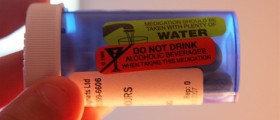
Use of alcohol includes some adverse effects that can be short term as well as long term. Alcohol goes directly into the bloodstream and because of that it physically affects the whole body. Most of these physical side effects can be reversed, when a person stops using alcohol but some side effects can be permanent. Alcohol is addictive substance that may lead into alcoholism that can cause heart and liver disease and other conditions. It may even cause death. On the other hand, it is believed that the moderate use of alcohol has certain benefits to health such as decreased risk of heart disease.
What is Alcohol and How does it Work?
Alcohol refers to ethanol or ethyl alcohol (C2H5OH) that is a volatile, flammable, colorless liquid. It has characteristic smell and it is highly soluble in water. Ethanol acts as central nervous system depressant and it is powerful hypnotic sedative. Depending on the level of alcohol in the blood the side effects increase. Blood alcohol content (BAC) represents concentration of alcohol in the blood.
At first, when a person ingests alcohol the effects include loss of inhibitions and causes person to feel relaxed and happy. Alpha waves in the brain are increased and cortex is stimulated due to alcohol intake when blood alcohol content is between 0.03 and 0.12%. This stage is known as euphoria.
Initially, alcohol has an anesthetic effect on mucous lining of the mouth and esophagus. When alcohol enters stomach, only 20 % of it is absorbed while the rest of 80% is absorbed by small intestine because of its large surface. Later, alcohol is distributed to cells of every organ through the blood stream.
Alcohol is metabolized by enzymes secreted by the liver. An enzyme called alcohol dehydrogenase converts alcohol to acetaldehyde that later gets converted into acetate. Acetate is the part of fats and in case of chronic alcohol use fatty acid levels increase. This can lead to liver cirrhosis due to formed plaque in the liver capillaries. When this vital organ is impaired it may lead to jaundice and hepatitis. Dehydration can also be the result of alcohol abuse since it induces secretion of anti-diuretic hormone because of which more urine is produced.
Alcohol is considered to be carcinogen because it can damage the cells’ DNA. Alcohol consumption is related to cancers of the mouth, larynx, pharynx and esophagus. This risk is particularly high among smokers since alcohol enhances carcinogenic property of tobacco.
General Effects of AlcoholDepending on the BAC alcohol has different effects on human body:BAC between 0.09 and 0.23% present in the body induce lethargy, loss of coordination and blurred vision.BAC between 0.17 and 0.28% present in the body leads to confusion, intensified emotions, aggression and nausea.BAC between 0.25 and 0.39% present in the body causes stupor and may lead to coma or death. BAC between 0.35 and 0.50 % present in the body causes coma, while BAC above 0.5% results in death.
















Your thoughts on this
Loading...